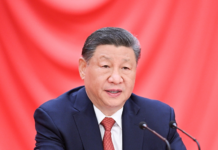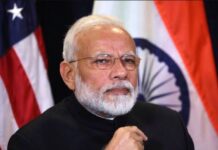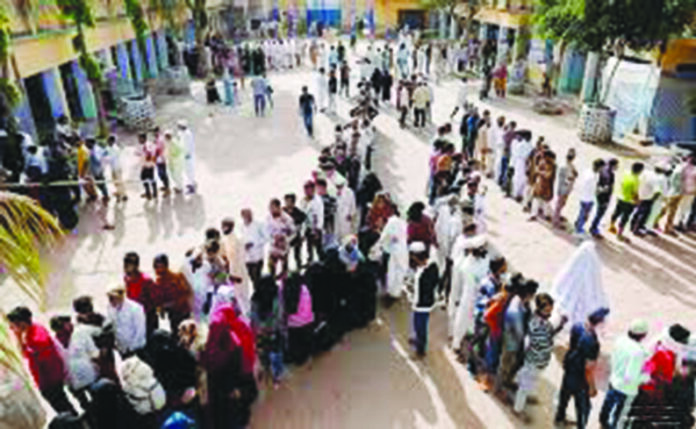AT PENPOINT
India started its polls on 19 April and will complete them on June 1, thus once again trashing the ideal of a same-day poll. As a matter of fact, these polls are going to be the longest since the 1951-1952 polls, the first after Independence, which were held between 25 October 1951 and 21 February 1952. Still, the 45-day polls this year are an improvement on the 119 days of that first election. That involved no less than 68 phases, with over 173 million voters from a population of 361 million. This time, there will be only seven phases, as in 2019.
This year, there will be around 968 million voters, about 150 million up from the last exercise, in 2019. Though the poll has missed being the first billion-voter election, it is likely that the next poll, due by 2029, will be. There were 109 million votes cast in 1951-52. There were 614.7 million in 2019, which indicates about 700 million in this election.
Even though there will be far less than a billion ballots cast in this and a few succeeding elections, counting the votes will remain a huge challenge. India is thus one of the countries using electronic voting machines.
One of the almost iconic practices it is meant to guard against is booth capturing, where a candidate’s supporters take over the booth, and then stuff the ballot boxes with pre-stamped ballots. EVM is shut down if voting is faster than five votes a minute, meaning that there is no way of stuffing. One can’t even do a bit of fancy techno-fraud, because the unit shuts down at any attempt to alter the programme after it is once installed.
One of the big differences between 1952 and 2024 is the number of state legislative assemblies also going to the polls, Back then, all did. The old legislatures had been elected in 1946, and were past their sell-by date. Then there were all of the princely states which had now acceded to the IIndian Union, which were wholly or partly now forming states, and which lacked legislatures. This time around, only four states (Andhra Pradesh, Arunachal Pradesh, Odisha and Sikkim) will go to the polls, while 25 by-elections to state legislative assemblies have also been scheduled.
As in 1951-2, the preceding Lok Sabha has not been dissolved, neither by the Prime Minister nor by the expiry of its tenure. That means that there will be a brief period when one Lok Sabha will be going into the sunset, and another preparing to take over. The sitting Lok Sabha will automatically expire on June 16. With the polls will be over on June 1, counting is planned for June 4, with the results coming in later, but without the urgency of having to fill an empty Lok Sabha. This is best when there is to be no change in government.
In 1952, there was no change expected, as Jawaharlal Nehru and the Congress were expected to win. They did, winning 364 seats out of 489, apart from 10 appointed members (now abolished). Again, no change is expected, In 2019, the BJP won 303 of 546 seats, but its allies took its National Democratic Alliance to 353. This time, it is aiming for 400 on its own. Nehru’s Congress party has gone through many vicissitudes, down to the dynasty having given up the Congress party, which after four generations of Nehrus and Gandhis, has since 2022 as President Mallikarjun Kharge.
For Pakistanis, the cacophony of the elections should not hide the fact that both the BJP and Congress are true patriots. The first wants Partition undone, the second broke Pakistan in 1971, and still glories in that.
Indira Gandhi, Jawaharlal’s daughter, is assumed to have started the dynasty, because she became PM. When she was assassinated, her son Rajiv became PM, and when he in turn was assassinated, his heirs took over the party, with first his widow Sonia becoming party President, and then son Rahul. However, the two Congress PMs after him, Narasimha Rao and Manmohan Singh, did not come from the family.
However, the family has been closely associated with the Congress since the time of Jawaharlal’s father Motilal. Motilal, a prominent member of the Allahabad High Court Bar, had bexcome President of the Congress. At that juncture, from the 1930s, he hobnobbed quite a lot with the Hindu Mahasabha, which through various twists and turns became the Jan Sangh and then flowed into the BJP.
It is commonly assumed that the BJP is merely the political arm of the RSS; but that is not really correct. The RSS was merely one of the strains of militant Hinduism rising up under the knowledge that the British were leaving. It is instructive that it was an RSS worker, Nathuram Godse, who assassinated Mahatma Gandhi in 1948. He did so because he and his political mentor, Vir Savarkar, who had been a Mahasabha leader, and who formulated the ideology of Hindutva and its central idea of a Hindu Rashtra, were opposed to Gandhi’s agreement to Partition.
After Gandhi’s assassination, Nehru, who had inherited his father’s political position, was left unchallenged in the party as well as the government. He was equally responsible for Congress accepting the Partition Plan which so incensed Godse and Savarkar, but he escaped Gandhi’s fate. It should be noted that where his father had hobnobbed with the Mahasabha, he collaborated harmoniously with Vallabhai Patel in the absorption of the Indian states into the Indian Union. Patel too was a militant Hindu, and the BJP looks favourably enough on him to retain the name of the Vallabhai Patel Stadium in Ahmedabad. However, the final of the 2023 World Cup was not played there, but at the Narendra Modi stadium, formerly the Motera Stadium.
The huge election exercise may seem excessive, even futile to some, for Modi’s re-election is not in doubt. The BJP can probably afford him and his Nehruvian popularity because he does not have any children in the wings waiting to take over, having married back in 1969, but having separated from his wife just months later. He does have three brothers, but none are close to him. As the example of Arun Nehru, a nephew of Jawaharlal’s and a great grandson of Motilal’s brother Nandlal, and thus a first cousin once removed of Jawaharlal, shows, unless you are a direct descendant, you don’t really stand a chance.
That means that Modi is supported for his policies, not his personality. This is apparently bucking the trend of South Asia, where families have established a sort of lien on electoral success. True the standard-bearer must hold true to what the predecessor stood for. Hasina Wajid in Bangladesh, for example, must remain pro-Indian. The inheritance does not seem to have gone into the fourth generation, and though the Nehru-Gandhis provide the sole example of the Prime Ministership of a country going to three generations, even though Bilawal Zardari Bhutto in Pakistan has got his hat in the ring, and so does Saeb Wazed in Bangladesh.
The implications are dangerous for Pakistan. The most important is that Indians are still wedded to the Hindutva ideology, and have not followed the Fabian Socialist inclinations of Jawaharlal Nehru. THis means that, despite the grand gesture of Modi’s predecessor Atal Bihari Vajpayee in visiting Iqbal Park, The BJP has still not accepted the Partition. And has no pressing reason to do so.
There is some hope that a PML(N) government and a BJP government could come together for peace, but that seems misplaced. There was little beyond tokenism ever achieved with Nawaz Sharif in office in Islamabad, and Modi and Vajpayee in New Delhi. Even when the military ruled in Pakistan, under Musharraf, only tokens were achieved.
For Pakistanis, the cacophony of the elections should not hide the fact that both the BJP and Congress are true patriots. The first wants Partition undone, the second broke Pakistan in 1971, and still glories in that.























